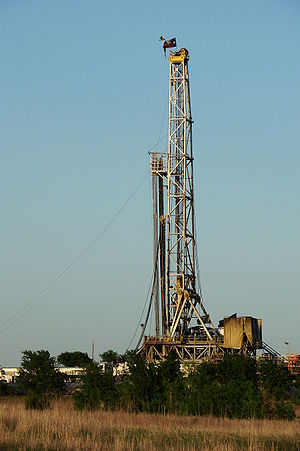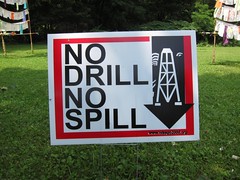
Environmental Risks
Advances in the horizontal drilling technique known as hydraulic fracturing over the past 10 years has greatly increased the use of the drilling technique by US energy companies in efforts to obtain large amounts of natural gas that was previously unattainable. Horizontal fracking drills are capable of reaching miles below the surface where the natural gas resides in large deposits of porous shale rock. These drills can turn sideways once they’ve reached this layer and bore horizontally into the shale layer. Water, sand and various chemicals are pumped into the well at high pressures, breaking apart the layers of shale and releasing the natural gas back to the surface. At face value this would seem to be a good thing for energy companies and their consumers alike. Currently natural gas accounts for approximately a quarter of all energy used in the United States. A more abundant natural gas supply could potentially offset the ever rising cost of oil and provide consumers with an alternative to it (oil) all together. The harvesting of natural gas is expected to become even more common in coming years due to that reason alone.
However, the environmental side effects of this procedure can hardly be classified as “tolerable” for residents who live nearby these drilling sites as well as for our planet. The potential for contamination of surrounding ground water from the chemicals used in fracking is very high. The fracking liquid along with the wastewater that is produced from this type of procedure is known to infiltrate nearby wells thus severely effecting local communities’ water supplies. Wastewater from hydraulic fracture drill sites is commonly stored in disposal wells which themselves have been blamed for causing “micro earthquakes” in areas such as Youngstown, Ohio which experienced a light, magnitude 4.0 quake in 2011 due to large volumes of wastewater in a nearby fracking disposal well. Many residents close to fracking sites have filed suit over drinking water contamination and well damage (well explosions) caused by the methane gas that is one of the chemicals used in the fracking fluid. The chemicals used in fracturing fluid have been known to spread into outlying areas and groundwater supplies further contaminating local water supplies.

The sheer amount of water usage alone for this type of drilling has raised concerns over fracking as well. A typical hydraulic fracturing drill requires 3 to 5 million US gallons of water over the course of its operational lifespan. The transport and storage of such large amounts of fresh water raise concerns from many different angles. Can the municipal systems support such a large use of local water? In a world consistently headed toward natural resource decline, this would seem to be an irresponsible use of one of our planet’s most valuable resources. Other concerns such as the dependability of well casing design, and transport of chemicals (possible chemical spills) seem relevant given the recent mishaps by large oil companies struggling to contain massive oil spills in the Gulf of Mexico. The EPA is currently shaping its policy regarding fracking and is taking in stories/research from both sides of the spectrum concerning the process with many saying this scrutiny by the agency is long overdue. Recently two environmental groups filed federal suit in Sanford, New York after the town banned discussion of hydraulic fracking at city board meetings. The town’s attorney has stated that in the minds of the board members, residents had “monopolized discussion” during the public participation of meetings thus hindering the board from addressing other business. Gov. Andrew Cuomo is expected to decide soon whether to lift a 4.5 year old moratorium on hydraulic fracking in the state. There is intense support on both sides of the issue as energy company lobbyists go head to head with local residents over the controversial drilling technique.
Business Risks
Energy company risks:
Insurance companies offer very little when it comes to coverage for hydraulic fracturing risks. Many have issued statements expressing a lack of information and or claims experience regarding fracking and therefore do not and will not write coverage for this specific type of risk. Many energy companies currently rely on limited pollution coverage under their policies due to the reluctance of insurers to write hydraulic fracturing risks into their policies. Most environmental impairment liability policies that are written are for well owners and contractors with very large fracking operations. Insurers are still very choosy as to what risks are written and rates generally depend at least partly on geographical locations and the size of the operation. Many energy companies still avoid spending the money on this type of coverage and instead rely on their general liability policies for coverage. Insurance underwriters are mainly concerned with well integrity, fracking processes, and the number of drills at each fracking site when evaluating and writing risks. Pollution coverage can sometimes be covered in a general liability or commercial lines policy if the well blowout and resulting pollution were “sudden and accidental” and if the incident is reported to the underwriter within 90 days. As with any type of coverage, policy wording is complex and different events will trigger different coverage.
From the property owner’s viewpoint:
Oil and gas company drill leases currently do not contain provisions for liability on the part of the drilling company. Property owners should be sure they are named as additional insured on all energy company policies if drilling is to occur on their land. That alone however is not enough. When the insurance company is left to choose they will most likely use a very narrow additional insured provision in the hopes of limiting their exposure to risks. It is best to set the terms of the additional insured provision with as much specification as possible as to the amount of coverage in the event of contamination by pollutants or damage to property buildings, homes, existing water wells etc… caused by the drilling. Most commercial general liability policies include pollution exclusions that the insurance companies rely on to deny coverage for the contamination by pollutants due to drilling. Energy companies can (and should) obtain specialty insurance for their specific (fracking) type of operation which does not include pollution exclusions or at least contains limited ones. Property owners and municipalities should stress this type of coverage before signing leases with drilling companies in order to avoid coverage denial due to pollution exclusions. The more involved property owners are in the writing and implementation of coverage the more prepared they will be if and when a loss occurs due to hydraulic fracturing. The only way for property owners or municipalities to be sure the energy company’s insurance policies meet their coverage standards is to obtain and review copies of all policies in effect regarding the drilling that is to occur. Another valid concern are the effects/damages that do not manifest during the duration of coverage but instead begin to show several years after drilling has occurred. Liability for these long term effects will very likely be a grey area when it comes to coverage and therefore should be addressed when shaping your policies.
Hydraulic fracturing has potential to provide large amounts of usable energy that is literally right underneath us. But it will not come about without environmental, societal and business risks. Attentive risk evaluation and management can and will help reduce risks to all of the parties involved. From property owners, municipalities and residents close to drill sites to energy companies and the insurers who are underwriting the risks, we are all involved in the proper assessment and implementation of risk management as well as environmental awareness when it comes to this type of procedure and the effects it has on us and our planet.


